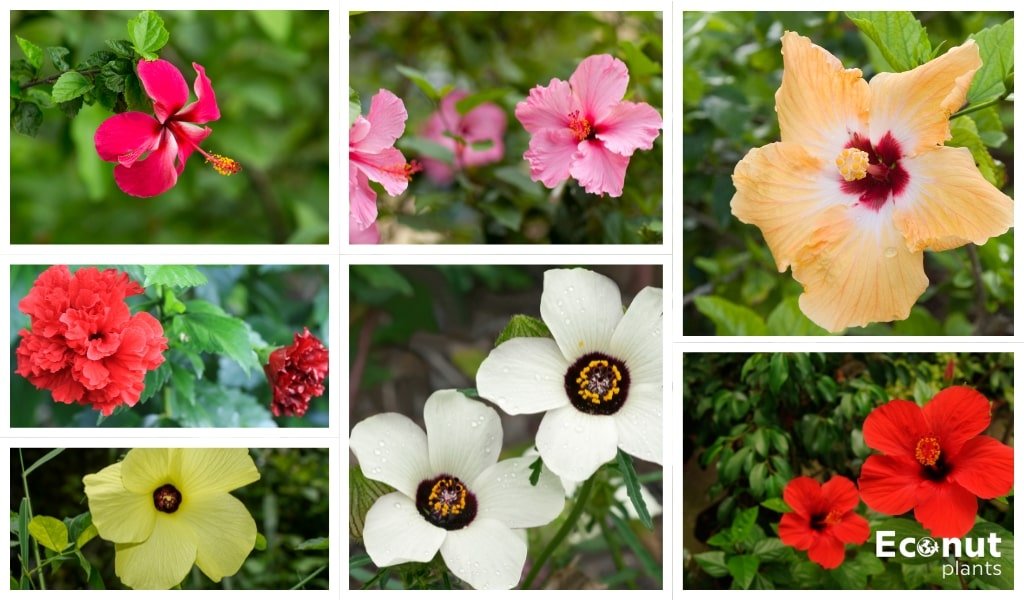If you’re not sure which kind of hibiscus to put in your garden, planting them can be difficult! Many cultivars may grow in a wide range of hardiness zones, each with its own unique colour of blossom. This post looks at some of our best hibiscus varieties for your house or garden!
Let’s talk about each hibiscus variety and take a closer look at some of the most well-liked species within every category.
1. Ardens

Scientific name: Hibiscus syriacus
Plant Type: Herbaceous perennial
Sun Exposure: Full sun, partial shade
Plant Size: 5-8 feet tall
Plant Zone: 5-8
Carnivers and other herbaceous perennials frequently get confused for the hibiscus Ardens type. They are, however, a particular type of hibiscus with divided petals that are somewhat violet or lavender in colour. Their ruffled borders and stacked petals give them a fluffy appearance.
Large, broad bushes support the blossoms, which give off a sea of green and some purple pops. If provided with adequate sunlight, they can withstand quite a bit of damage and thrive in practically any type of soil.
2. Hibiscus ‘Palm Springs’
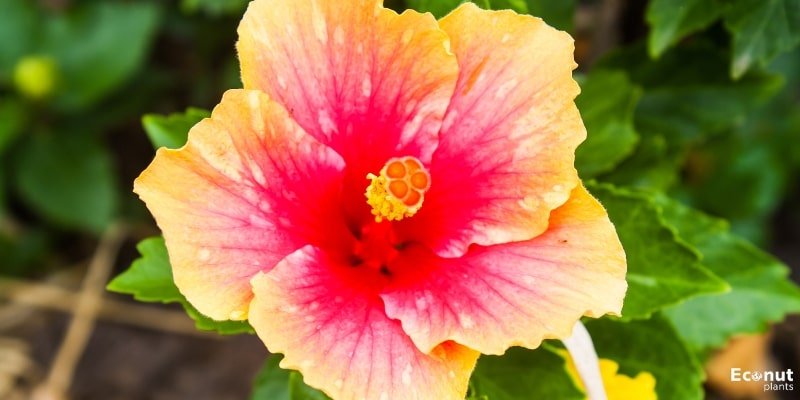
Scientific name: Hibiscus rosa-sinensis
Plant Type: Perennial
Sun Exposure: Partial shade
Plant Size: 4-6 feet
Plant Zone: 10-12
The blossoms on this type of tropical hibiscus are incredibly colourful. Their blooms usually have a diameter of six to eight inches. The outside margins of the petals are a vivid shade of deep yellow, while the center of the bloom is coloured a bright orange that, from a distance, looks nearly like a star.
3. Crown of Bohemia Hibiscus
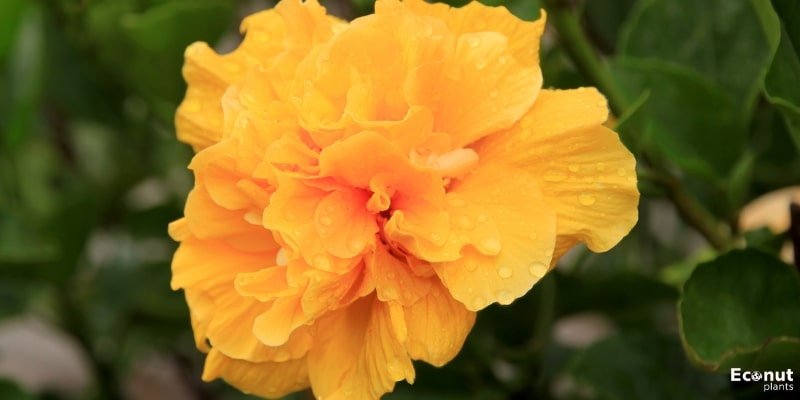
Scientific name: Hibiscus rosa-sinensis ‘Crown of Bohemia’
Plant Type: Evergreen shrub
Sun Exposure: Full sun to Partial shade
Plant Size: 8-10 feet
Plant Zone: 10-11
Beautiful yellow-to-deep-orange double-blooming hibiscus flowers are produced by this tropical shrub. It blooms all year long and thrives in the heat of Arizona.
It makes a great hedge or screen because of its lush, deep green foliage. This gorgeous tropical plant makes a great focal point in any garden and requires very little maintenance. It can be trained to grow into a hibiscus tree and thrive in containers.
4. Swamp Rosemallow

Scientific name: Hibiscus Moscheutos
Plant Type: Perennial
Sun Exposure: Full sun
Plant Size: 3–8 feet
Plant Zone: 4-9
A hardy type of hibiscus native to North America that grows well in marshes is Hibiscus moscheutos. Along streams or ponds, this lovely hibiscus grows. White, pink, or rose petals make up its petals. “Crimson-eyed rosemallow” is the moniker given to it because of its characteristic red “eye” in the center.
Similar to Hibiscus syriacus, the Hibiscus swamp mallow is a hardy shrub. It grows best in direct sunlight and can tolerate both dryness and humidity. Moreover, Hibiscus grandiflorus is its botanical name.
5. Anne Arundel
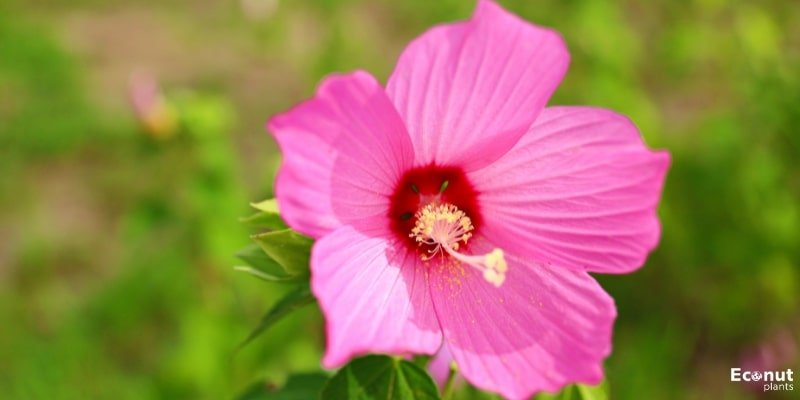
Scientific name: Hibiscus moscheutos
Plant Type: Perennial
Sun Exposure: Full sun
Plant Size: 4–5 feet
Plant Zone: 5-9
The stunning, brilliant pink blooms of the Anne Arundel hibiscus, also known as the rose mallow hibiscus, can reach several feet in height and occupy a significant amount of area in your garden. This type likes some sun, so place it where it will get plenty of it throughout the day, especially in the morning.
Although less-than-ideal soil can be tolerated, it thrives in rich, moist soil. The huge, soft, delicate petals of the bloom give it a striking appearance.
6. Blue Bird
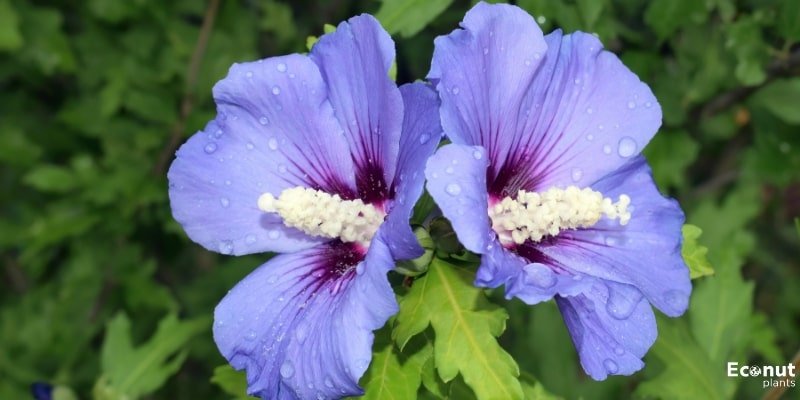
Scientific name: Hibiscus syriacus
Plant Type: Deciduous shrub
Sun Exposure: Full sun, Partial sun
Plant Size: 6-8 feet
Plant Zone: 4-9
Blue Bird’s Rose of Sharon is a huge, fast-growing deciduous shrub that belongs to the family Malvaceae, which includes marshmallows. Large violet, blue, pink, or purple trumpet-shaped flowers bloom for a long time from summer into fall on this multi-stemmed shrub with a vase-like spherical form.
7. Blue River II
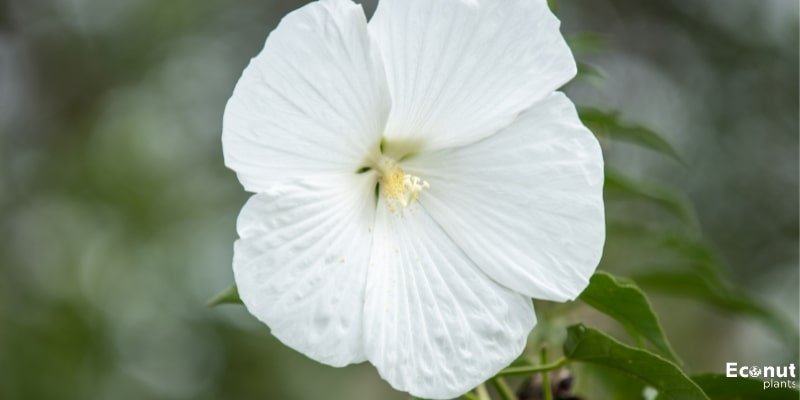
Scientific name: Hibiscus moscheutos ‘Blue River II’
Plant Type: Perennial
Sun Exposure: Full sun
Plant Size: 4-5 feet tall
Plant Zone: 4-9
This variety of hibiscus grows to be 6 to 10 inches across, with pure white blossoms. Though this hibiscus has a short flowering period, you will still be able to enjoy around 240 blooms that will occur during the spring and summer. The white flowers nearly give your garden night-time light.
8. Cotton Rose
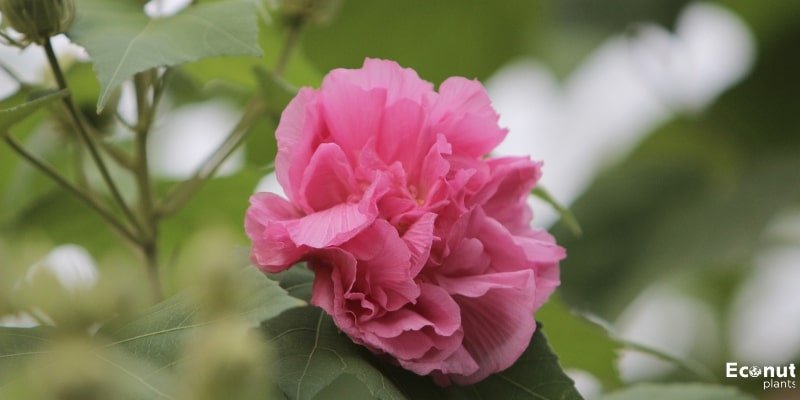
Scientific name: Hibiscus mutabilis
Plant Type: Perennial Shrubs
Sun Exposure: Full sun
Plant Size: 6-15 feet
Plant Zone: 7-11
Cotton roses grow quickly, to the point where they more closely resemble trees than shrubs. The big, long-blooming flowers of this low-maintenance, deer-resistant hibiscus variety are recognized for their colours of white, pink, and red.
The plant’s fuzzy seed pods, which give it its popular name, follow the petals. In late winter or early spring, remove any dead growth from the previous growing season.
9. Bold and Sassy
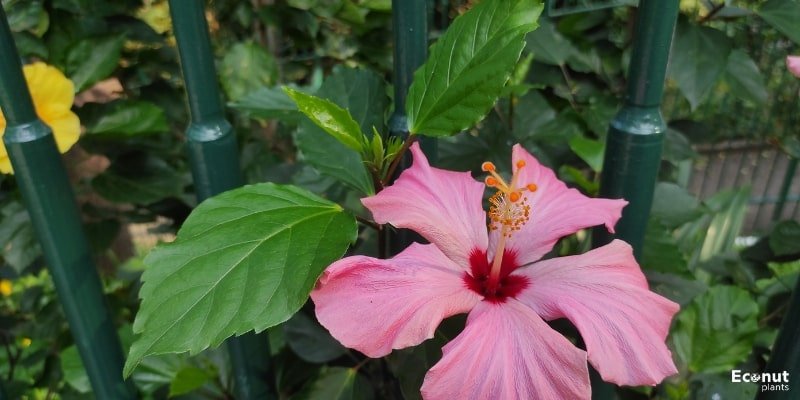
Scientific name: Hibiscus rosa-sinensis
Plant Type: Annual
Sun Exposure: Full sun, Partial Shade
Plant Size: 2-4 feet
Plant Zone: 9-11
This beautiful tropical hibiscus plant is not to be confused with the hardy varieties that are usually found at your neighbourhood nursery. They are more challenging to find and consequently more difficult to proliferate. These beauties won’t let you down once you get your hands on them!
10. Confederate Rose
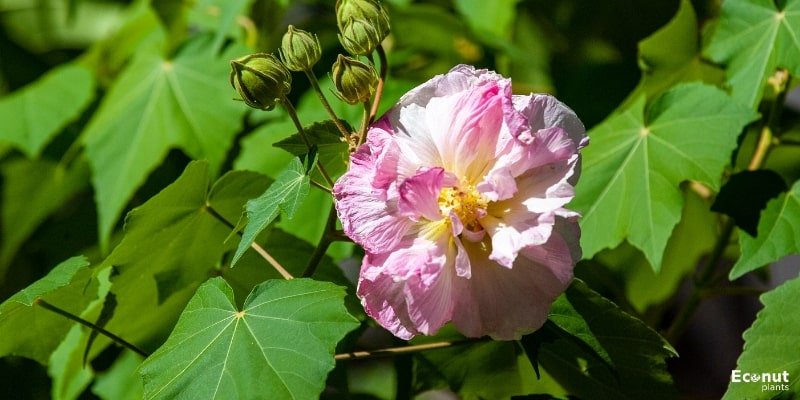
Scientific name: Hibiscus Mutabilis
Plant Type: Shrub
Sun Exposure: Full sun
Plant Size: 12–15 feet
Plant Zone: 9-10
A different kind of hibiscus plant with an ambiguous name is the Hibiscus Mutabilis Confederate Rose. Though popular all around the world, its origins are in China. Rather than a rose, it is a hibiscus.
Hibiscus mutabilis produces flowering stems that resemble roses due to their remarkable beauty. During their lifespan, the petals of certain hibiscus types can undergo colour changes. When circumstances are right, hibiscus mutabilis flowers can change colour multiple times during the day.
Early in the day, the petals are white; by lunchtime, they are a fiery pink; by the evening, they are crimson. Showing off mutabilis in a garden or landscape is a popular flower. Growth and upkeep are both simple.
Bold and Sassy hibiscus petals flutter and flow in gorgeous pastel colors, evoking the image of a flamenco dancer. Make sure to plant your Bold and Sassy in a location that receives full to partial sunlight and slightly acidic soil.
11.Berry Awesome

Scientific name: Hibiscus x ‘Berry Awesome’
Plant Type: Perennials
Sun Exposure: Full sun
Plant Size: 4 feet tall
Plant Zone: 4
Berry Awesome has rich midnight green foliage with contrasting lavender-pink flowers and a red eye. Unlike some other cultivars, which only produce flowers at the top of the plant, this one produces flowers down the plant?
From late summer into early fall, the leaves create the ideal habit and are eager to show off. For sunny borders, “Berry Awesome” makes the ideal backdrop or focal point. In your garden, use it in place of a shrub.
12. Black Dragon
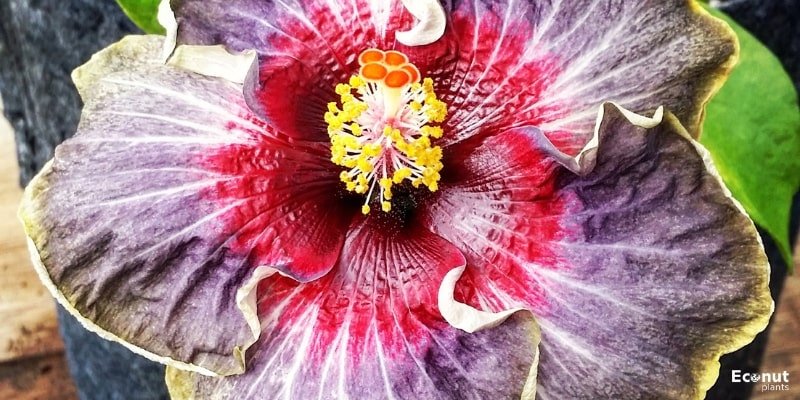
Scientific name: Hibiscus rosa-sinensis hybrid
Plant Type: Evergreen shrub
Sun Exposure: Full sun
Plant Size: 8–10 feet
Plant Zone: 9-11
This Black Dragon variation of black hibiscus, which is synonymous with exoticness, has a deep burgundy colour instead of being completely black. This unique variety of hibiscus became even more beloved and remarkable when it was named “The Hibiscus of the Year” by the American Hibiscus Society in 2005.
These were just a handful of the varieties of hibiscuses; if we continued talking about them, the list would be endless. Each flower speaks a different language of love and has its own charm. Remember to let it bloom rather than pluck it to truly experience the love!
13. China rose

Scientific name: Hibiscus rosa-sinensis
Plant Type: Shrub
Sun Exposure: Full sun
Plant Size: 6–8 feet
Plant Zone: 7–8
Popular Asian shrubs like the China rose are also referred to as “blackening plants” since the flowers are used in tropical climates to polish shoes. The plant mostly yields red blooms, but it can also produce single, double, pink, orange, and yellow petals.
14. Cheeky Point
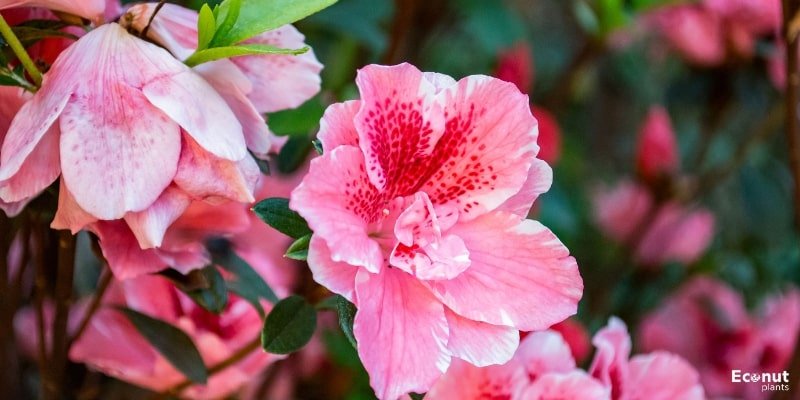
Scientific name: Hibiscus rosa sinensis
Plant Type: Perennial shrub
Sun Exposure: Full sun, partial shade
Plant Size: 8-12 Inches tall
Plant Zone: 4-9
The look of the Cheeky Point or Cheeky Fellow varieties of hibiscus is unique and lovely. They usually have orange accents and are hot pink in colour, giving them an exotic, tropical appearance. Each blossom has an attractive appearance due to the swirling pattern of the petals overlapping one another.
The way each petal is arranged is so exquisite and unique that they almost appear manufactured. Although they are not too difficult to grow, these blooms do require a lot of sunlight and water.
15. Sleepy Hibiscus
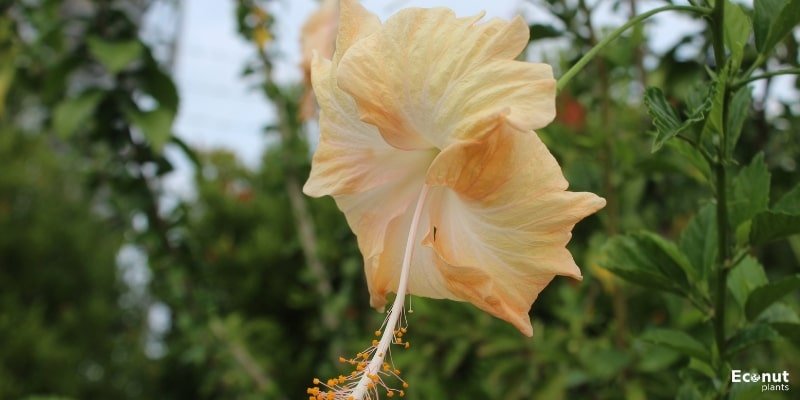
Scientific name: Hibiscus furcellatus
Plant Type: Perennial
Sun Exposure: Full
Plant Size: 6-10 feet
Plant Zone: 5–9
A wonderful shrub for landscaping in hedges or pots is the Hawaiian Furcellatus, a hibiscus that may reach heights of 6 to 10 feet. It thrives in moist soil and yields beautiful, year-round purple and pink flowers when planted next to streams.
These blooms are a great addition to any garden because of the contrast between the heart-shaped leaves and the green foliage.
16. Texas Star Hibiscus
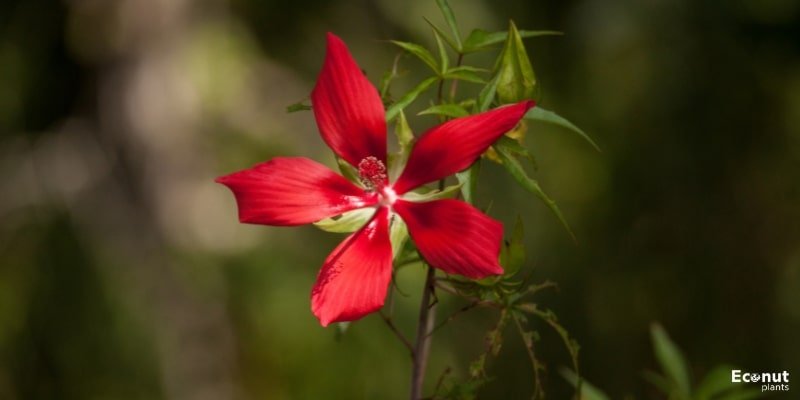
Scientific name: Hibiscus coccineus
Plant Type: Perennial
Sun Exposure: Full
Plant Size: 6-8 feet
Plant Zone: 5–9
Hibiscus coccineus, also called the scarlet rosemallow, is found in Texas. This resilient hibiscus species is indigenous to the southeast region of the country. It is not found in Texas, despite its name. However, the Lone Star Hibiscus is a variety with white petals.
The five red petals and glossy, eye-catching foliage of Hibiscus coccineus are well-known features. While it can withstand heat and humidity, it will wither away in the winter’s chill. The Texas Star Hibiscus is a great addition to garden streams or ponds and, like Hibiscus moscheutos, is partial to swampland.
18. Blue Chiffon
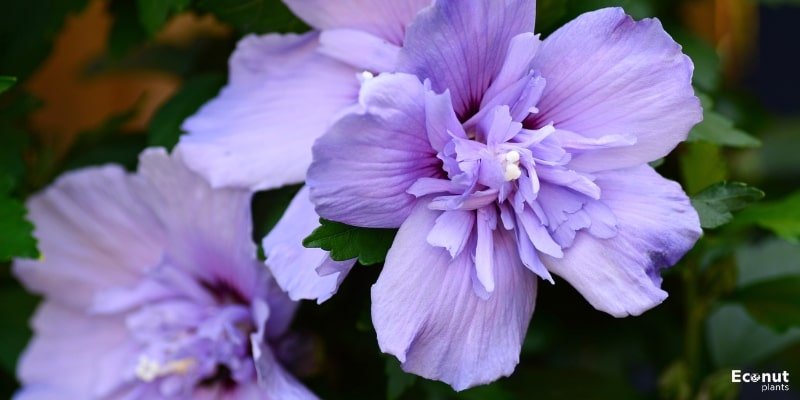
Scientific name: Hibiscus syriacus
Plant Type: Deciduous shrub
Sun Exposure: Full
Plant Size: 8-12 feet
Plant Zone: 5–9
‘Blue Chiffon’ is one of the many unique cultivars of rose of Sharon; it’s a specimen with unusual blue-tinged blossoms and a lacy ruffle of inner petals. This tall shrub has a rounded growth habit and does well in a range of soil types that drain well. Expect blossoming to start in late summer and continue into autumn.
19. Delta Dawn

Scientific name: Hibiscus rosa-sinensis
Plant Type: Annual
Sun Exposure: Full sun
Plant Size: 6-8 feet
Plant Zone: 9-10
A unique new Cajun hibiscus hybrid with a beautiful flower colour combination is called Delta Dawn. The 7″ bloom has a scarlet-red center. These changes to gorgeous lavender petals, with grey and light yellow accenting the frilly petal margins. Like all hibiscus, this one should be grown in full sun with lots of water and fertilizer to maximize flowering.
20. Hibiscus ‘Queen of Dreams’
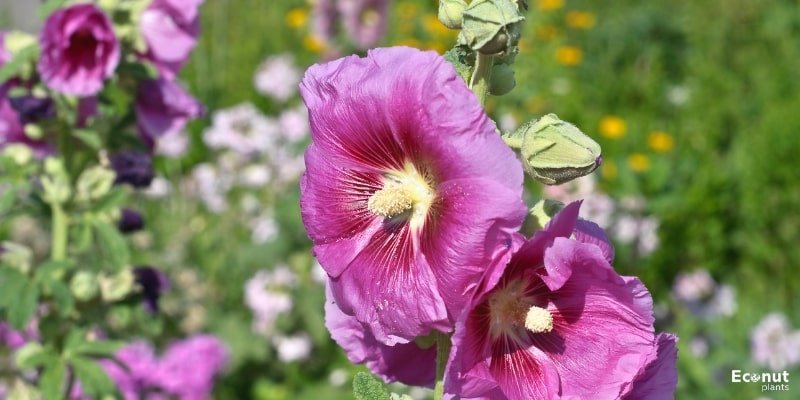
Scientific name: Hibiscus rosa-sinensis ‘Queen of Dreams’
Plant Type: Evergreen, Deciduous
Sun Exposure: Full sun
Plant Size: 4–10 feet
Plant Zone: 9, 10, 11
Hibiscus rosa seninsis, also known as the Tropical Hibiscus Queen of Dreams, is a beautiful hybrid hibiscus that yields huge, fancy, frilled, thick double flowers in a variety of peach, pink, and lavender tones. It’s a highly sought-after and relatively uncommon hybrid.
21. Hibiscus ‘Christmas Angel’

Scientific name: Hibiscus rosa-sinensis ‘Christmas Angel’
Plant Type: Evergreen shrub
Sun Exposure: Full sun
Plant Size: 2-4 feet
Plant Zone: 9-11
Hibiscus rosa-sinensis hybrid, Hibiscus Tahitian ‘Christmas Angel’ Hibiscus Tahitian ‘Christmas Angel’ flower is a great addition to your hibiscus collection. It features an incandescent white center that radiates outward, creating a gorgeous floral display with vivid red petals.
22. Summer Storm
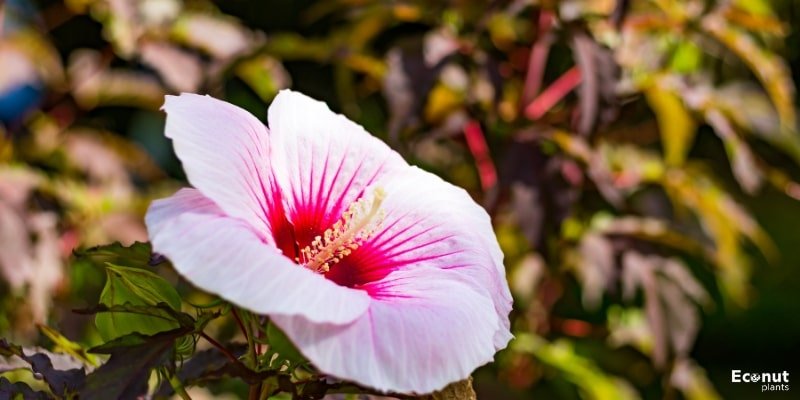
Scientific name: Hibiscus moscheutos
Plant Type: Perennials
Sun Exposure: Full sun
Plant Size: 3-4 feet
Plant Zone: 5
Large blossoms with layers of tiny, delicate petals that are many inches broad are characteristic of summer storms. They appear thick and juicy because of the layers they create when they overlap.
Depth and drama are created by the massive tubular flowers, which are delicate pink in colour with a deep purple eye in the middle. Large, incredibly dark green leaves that are evenly spread give the bush a light, airy aspect as opposed to a thick bush.
23. Brackenridge
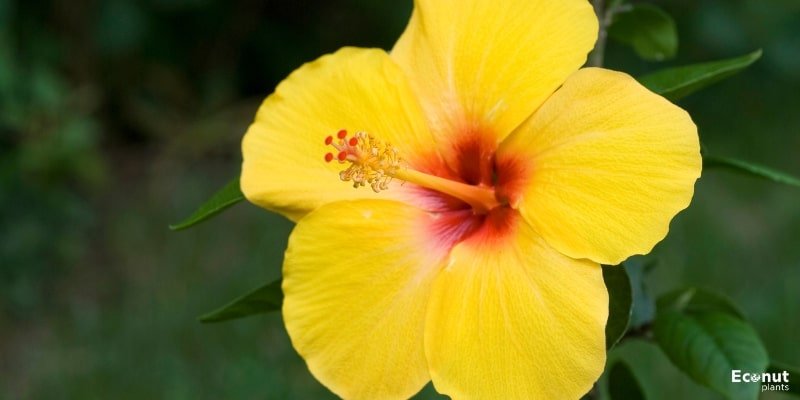
Scientific name: Brackenridgei
Plant Type: Perennial
Sun Exposure: Full sun
Plant Size: 5–8 feet
Plant Zone: 9-11
The most popular use for Hibiscus brackenridge is as an outdoor decorative plant. This shrub with yellow flowers can reach a height of five meters. They may bloom alone or in clusters that grow at the tips of the branches.
This vibrant yellow flower is a great option for plant enthusiasts who prefer not to handle strong-smelling flowers because of its delicate fragrance.
24. Flower of an Hour
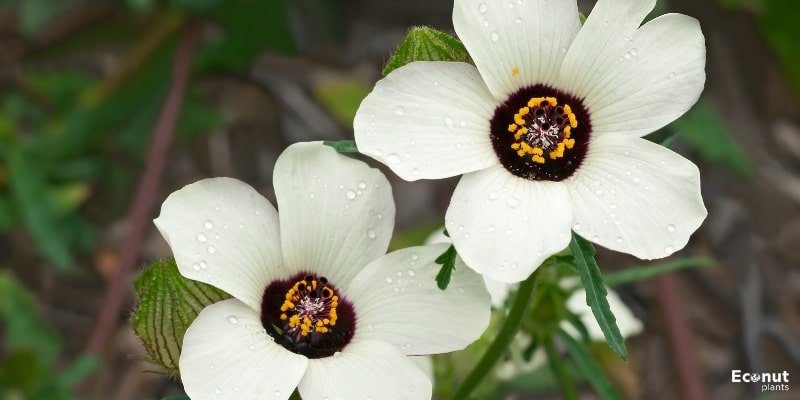
Scientific name: Hibiscus trionum
Plant Type: Annual
Sun Exposure: Full sun
Plant Size: 8–20 in
Plant Zone: 9-11
Another name for this type of flower is hibiscus trionum. The plant can reach a height of four to five feet and bear flowers that range in colour from cream to yellow. The flower of the hour can also make a wonderful adornment!
25. Phillip Island Hibiscus

Scientific name: Hibiscus insularis
Plant Type: Shrubs
Sun Exposure: Full sun
Plant Size: 2.5 m
Plant Zone: 9–13
Insularis, a unique variety of Hibiscus native to an Australian island off the coast, is also referred to as the Phillip Island Hibiscus Bloom. Its shape is similar to a starfish, and its stamens are prominent.
In its natural range, this plant—which is extremely endangered—is found in tropical environments. It grows in an odd way; in the wild, it forms two bunches. You will need strong support if you wish to use it to make a hedge or privacy screen.
26. Rock Hibiscus

Scientific name: Hibiscus denudatus
Plant Type: Perennial shrub
Sun Exposure: Full sun
Plant Size: 2–4 feet
Plant Zone: 7
God’s art is found in nature. Looks accurate when we observe this specific hibiscus cultivar. Though it can also be purple in colour, rock hibiscus is often pink.
Especially indigenous to Mexico and the US, this type may even reach elevations of up to 2,000 feet, which truly astounds us! One of the most exquisite hibiscus kinds is the rock hibiscus scattered bloom, which has five petals that are each three inches in diameter and triangular leaves.
27. Cosmic Dancer
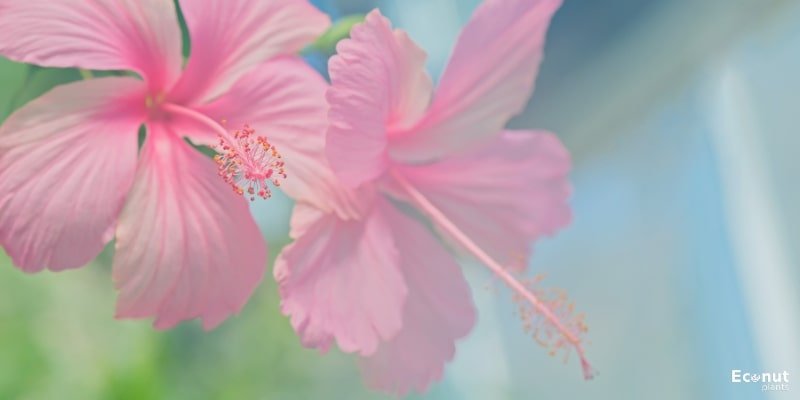
Scientific name: Hibiscus rosa sinensis
Plant Type: Perennial
Sun Exposure: Full sun
Plant Size: 5 feet tall
Plant Zone: 11
The exotic-looking, tropical-looking Cosmic Dancer kind of hibiscus can liven up even the most boring yard. It features enormous petals and the elongated shape that tropical hibiscus flower varieties are recognized for, giving it a similar appearance to the fiesta hibiscus.
This variety of hibiscus is a must-have if you want to create a striking display for your guests and fellow gardeners. It is not difficult to maintain, although it likes to spend as much time in the sun as possible. Typically, the petals have yellow accents around the margins and are a deep hue of orange, pink, or red.
28. Abelmosk

Scientific name: Abelmoschus moschatus
Plant Type: Annual
Sun Exposure: Full sun
Plant Size: 2–6 feet
Plant Zone: 9-11
Abelmosk is an annual cultivar that is native to India and grows up to 6 feet tall. Bright yellow-lime green petals with dark green centers adorn its blooms.
The scent of the blooms from this cultivar is musk-like, and the seeds can be added to coffee. Since it’s regarded as a weed, planting it in pots will be preferable!
29. Rose of Sharon ‘Lil Kim’

Scientific name: Hibiscus syriacus ‘Lil Kim’
Plant Type: Deciduous shrub
Sun Exposure: Full sun
Plant Size: 3–5 feet
Plant Zone: 5-9
Though ‘Lil Kim’ is a rose of Sharon cultivar that reaches a maximum height of approximately four feet, it’s still a great option if you like the appearance of this particular hibiscus species but lack the room for towering, bushy plantings.
This small shrub has large, intense red centers and strong veining in plenty of white blossoms. To enjoy blossoms throughout the summer, plant it in a container or along a border.
30. Woodbridge
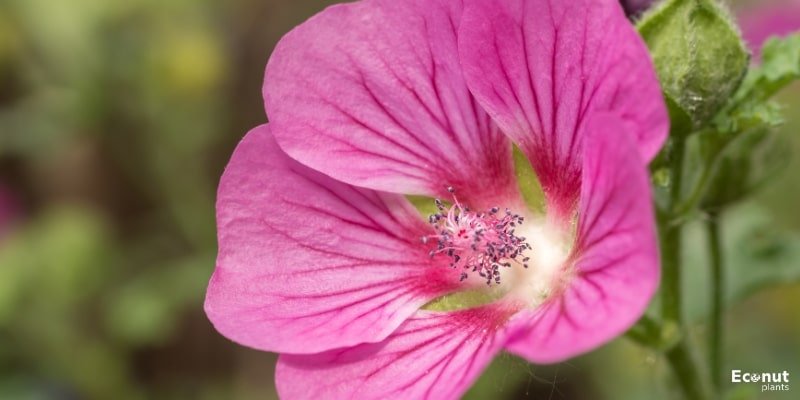
Scientific name: Hibiscus syriacus
Plant Type: Deciduous shrub
Sun Exposure: Full sun
Plant Size: 10 feet
Plant Zone: 5-9
The shrub known as Woodbridge hibiscus originates in the jungles of Eastern Asia. Huge fuschia-pink flowers that develop in a spiral pattern adorn this tall, erect shrub.
This particular variety of hibiscus blooms is easily recognized due to its deep pink colour, which becomes darker towards the petal’s outer edge. The plant only needs good sun and healthy soil to flourish; it doesn’t require much maintenance or pruning.
31. Luna Red
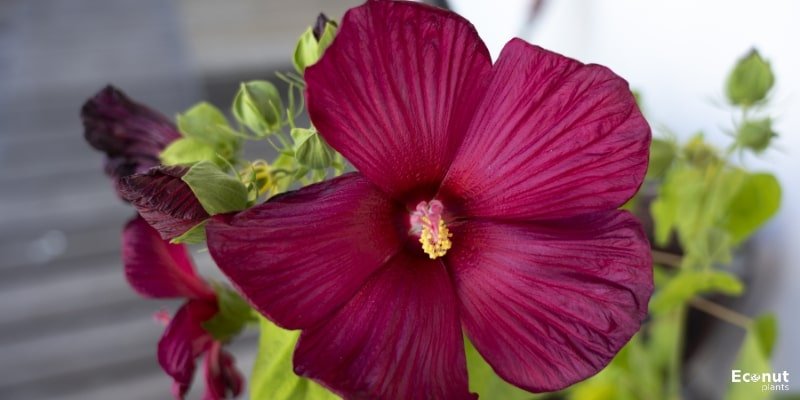
Scientific name: Hibiscus moscheutos ‘Luna Red’
Plant Type: Perennial
Sun Exposure: Full sun
Plant Size: 2-3 feet
Plant Zone: 5-9
The Hibiscus luna red is a small, bushy shrub with bright green foliage and five-petaled flowers. In well-drained, healthy soil, the plant yields flowers that are 6 to 8 inches across. This type returns in the summer after dying back to the ground in the winter.
32. Hibiscus ‘Voodoo Queen’
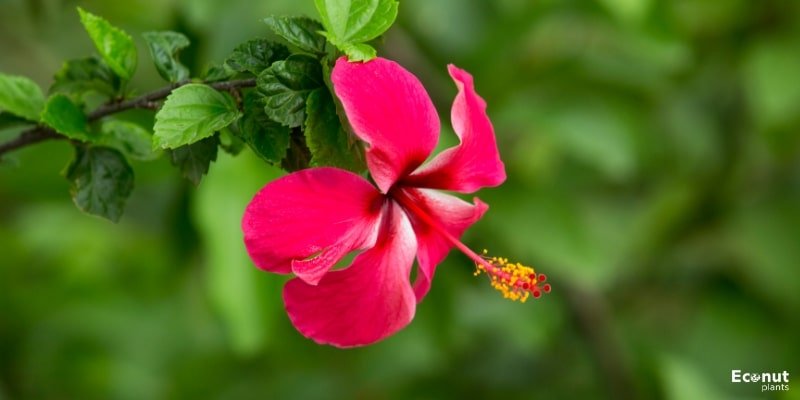
Scientific name: Hibiscus rosa-sinensis ‘Voodoo Queen’
Plant Type: Evergreen shrub
Sun Exposure: Full sun
Plant Size: 2-4 feet
Plant Zone: 9-11
This colour-changing hibiscus blooms reddish-orange in the morning, turning purple in the center and red in the throat. The tint shifts to a golden with lavender-gray centers around afternoon. Shiny, dark green leaves contrast sharply with seven-inch blossoms. In the summer, give this plant lots of sunlight, water, and fertilizer. In colder climates, keep plants in containers.

